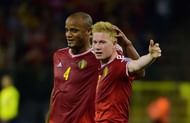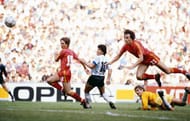In 1993, when FIFA world rankings were introduced, Belgium men’s team were ranked 25th. Cut back to 2015 and Belgium achieved their highest ever rank – 1st. How did a country of only 11 million people and with only 34 professional clubs in 2 divisions manage to become the best or at the very least the most consistent footballing nation?
Let us take a look at the story behind Belgium’s immense improvement over this short period of time.
The background
In 1986, a talented Belgium team boasting of players like Enzo Scifo, Jan Ceulemans and Franky Vercauteren reached the semi-final of the FIFA World Cup but on 25th June, in Mexico City lost to Argentina 2-0, courtesy of two goals from none other than Diego Maradona. Argentina eventually went on to make history by defeating West Germany in the final while Belgium lost to France in the 3rd place match.
This was followed by exits at the Round of 16 stage in both 1990 Italy and 1994 USA World Cups. Belgium’s performance reached an all-time low when they were eliminated at the group stage in 1998 France World Cup and in Euro 2000 on home soil.
The successive failures led to the appointment of Michael Sablon, who was the assistant coach of Belgium in ’86, ’90 and ’94 World Cups, as the technical director (TD) of the Royal Belgian Football Association (RBFA), also known as URBSFA (in French) and KBVB (in Dutch).
Change of formation
In 1998, 30 RBFA coaches already had a meeting to discuss possible changes to improve the abysmal condition of Belgian football at that moment. Based on the youth academies of their more successful neighbours France, Netherlands and Germany, they had decided to implement a nationwide change in playing formation for all the clubs at all age levels.
Before that, the most dominant playing style in Belgium was either 4-4-2 or 3-5-2 with extensive man marking. The goal was to play very defensively in an organized manner to win matches. This system was producing hard working runners who played according to their opponent’s style rather than be creative on their own.
The committee decided to implement 4-3-3 formation where players would play in zones and learn to think about the positions of other players on the field and would learn to play freely. Their hope was to produce more skilful individual players, instead of worrying about the team results.
Sablon’s vision
When Sablon became the TD in 2001, he decided to put the revenue from Euro 2000 to good use. A football training centre was set up just outside of Brussels. Entry level coaching courses were made available for free, which increased the number of people in these courses hugely.
Also, he commissioned Professor Werner Helsen of KU Leuven to study the youth footballing system and come up with suggestions to improve the system. Professor Helsen and his 6 students recorded 1500 hours of youth football matches and specifically studied things like short passes, long passes and number of touches by a player.
This way of scientifically looking at football proved to be a game changer. The most important finding of this study was that players at this level, on average, touched the ball only twice in whole 90 minutes which clearly showed how unlikely it was for a player to develop individual skills in such a system.
This prompted Sablon to implement a radical change. He made teams at a very young level play 5 vs. 5 matches and at youth level play 8 vs. 8 matches, delaying the inception of full 11 vs. 11 matches to a much older age. The idea was to have players excel at diagonal passing and dribbling in 1 vs. 1 situations. Ball circulation was given utmost importance, eradicating goal kicks, free kicks. Throw-ins were replaced with kick-ins.
Also Read: Thierry Henry becomes an instant hit with Belgium national team stars in first training session
Another important finding was that too much emphasis was given on winning rather than the development of players. To improve upon this, league tables at under-7 and under-8 stages were scrapped, similar to the system in England’s youth academies.
Belgian government also pitched in. In a joint initiative of RBFA and Belgian government, eight centralized football schools were set up for players in the age group of 14-18. The rationale behind this was to have young footballers practise in these football schools in the morning, 4 days a week, for 2 hours each day, before they headed out to school.
Belgium being a very small country, the close proximity of these schools allowed its students to commute from home and be able to go to practice in the club academies in the evening. In these schools, the best players from all over the country were scouted and trained.
Notable players to come out of these schools are:
Dries Mertens (Napoli);
Axel Witsel (Zenit Saint Petersburg);
Moussa Dembélé (Tottenham Hotspur);
Simon Mignolet (Liverpool).
The outcome

As a consequence of all these changes, the Belgium U-17 & U-19 teams reached the top 10 in 2009. As more and more Belgium players did well in youth level and got noticed by the biggest clubs, the presence of Belgian players playing abroad in big clubs increased. For example, there were just 2 Belgian players playing in the English Premier League in 2008, and now, most of the big clubs in the Premier League are full of Belgian players.
Some of the biggest names are:
Vincent Kompany, Kevin de Bruyne (Manchester City);
Thibaut Courtois and Eden Hazard (Chelsea);
Marouane Fellaini (Manchester United);
Simon Mignolet (Liverpool);
Jan Vertonghen, Moussa Dembele, Toby Alderweireld and Nacer Chadli (Tottenham Hotspur);
Romelu Lukaku and Kevin Mirallas (Everton).
Criticism
The criticism against attributing Belgium’s success solely to these changes is rife. Some link the success to the immigration of people from various African countries to Belgium in recent times. Notable players with at least one non-Belgian parent are:
Lukaku, Kompany and Christian Benteke (Congo);
Chadli and Fellaini (Morocco);
Dembélé (Mali);
Witsel (Martinique).
The other explanation is that most of Belgium’s biggest players were developed outside the country from a very young age, such as:
Hazard, Mirallas and Divock Origi (Lille);
Januzaj (Manchester United);
Thomas Vermaelen, Vertonghen, Alderweireld (Ajax);
Dembele (AZ);
Chadli (MVV).
Also Read: Is Belgium's golden generation following the path of Portugal's golden generation?
What can India learn from them
Although it is hard to pinpoint the exact reason behind Belgium’s rise as an elite footballing nation, it will be foolish to disregard the contribution of the changes Michael Sablon implemented. It took such a small country as Belgium with only 11 million people, just 9 years from the introduction of Sablon’s plan for Belgian football, ‘La vision de formation de l’URBSFA’ in 2006 to reach the number 1 spot in 2015.
Why cannot India with a population of 100 times more than Belgium do the same thing by 2026?

